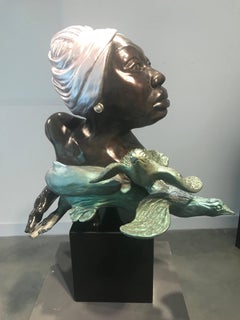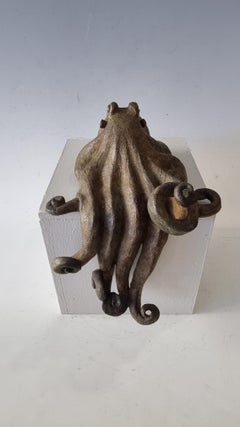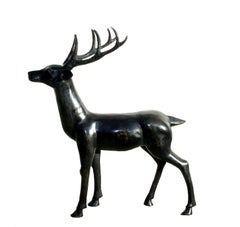Deborah Philips Art
to
1
Overall Width
to
Overall Height
to
1
1
1
1
9,980
2,753
1,376
1,373
1
Artist: Deborah Philips
Nina Simone-Feeling Good -Bronze 26"
By Deborah Philips
Located in West Palm Beach, FL
Nina Simone- Feeling Good Bronze
If you are a fan of Nina Simone, you know how beautifully the piece is executed.
"Feeling Good" - Birds flying high, Fish...
Category
2010s Realist Deborah Philips Art
Materials
Bronze
Related Items
0ctopus Bronze by Sophie Martin 3/8
By Sophie Martin
Located in Pasadena, CA
Animal sculptor Sophie MARTIN creates from inert clay a whole living animal kingdom.
She freely observes the animal and captures and interprets a movement; and places it in nature an...
Category
21st Century and Contemporary Realist Deborah Philips Art
Materials
Bronze
Deer, Large Patinated Bronze Sculpture
Located in Long Island City, NY
This bronze sculpture of a deer is a realistic rendering of the majestic animal. Deer have been the center of literature and art for many cultures across the world. They have also ...
Category
20th Century Realist Deborah Philips Art
Materials
Bronze
Antique Horse Bronze Trotting Stallion Isidore Jules Bonheur (France, 1827-1901)
By Isidore Jules Bonheur
Located in SANTA FE, NM
Antique Horse Bronze
Portrait of a Trotting Stallion
Isidore Jules Bonheur (France, 1827-1901)
Cast bronze mounted on a rectangular plinth with dark brown patina,
Signed: I. BONHEUR
17 x 11 3/4
A brilliant exploration of a stallion in full trot. The patina is a deep, warm walnut brown with honey-colored tones.
Isidore Bonheur was best known and the most distinguished of the 19th century French animalier sculptors. Isidore, the younger brother of Rosa Bonheur and older brother of Auguste, began his studies of painting initially with his father, who was friends with Francisco Goya. By 1848 he debuted at the Paris Salon having discontinued animal and landscape painting to concentrate on creating sculptures and in 1849, Bonheur enrolled at the Ecole des Beaux Arts. He won medals at the Paris Salon in 1859 and did so again in 1865 and in 1869. After entering the Exposition Universelle 1855, he won the Gold Medal in 1889. In the 1870s exhibited in the London at the Royal Academy of Arts where he earned great prestige and won the coveted Medaille d’Or. After winning numerous other medals and prizes, Bonheur was awarded the Legion d' Honneur in 1895 and he was Knighted in Portugal, Spain and France. Bonheur continued exhibiting at the Paris Salon until 1899.
Many of his bronzes were fabricated at the foundry owned by Hippolyte Peyrol, Bonheur's brother-in-law by marriage to Isidore’s youngest sister Juliette Bonheur. The Peyrol casts for both Rosa and Isidore are exceptionally well executed which suggests a strong working relationship between the founder and sculptor. There is little doubt that Isidore Bonheur was an acute observer of nature; his animals were not anthropomorphized but modelled to catch movement or posture characteristics of the particular species he was sculpting. He achieved this most successfully with his sculptures of horses which are usually depicted as relaxed rather than spirited. These figures are among his most renowned works and his equestrian models became very popular, particularly among the British aristocracy.
An acute observer of nature, his sculptures reflect his commitment to the Realist school - with precise detailing of the movements of animals in their natural habitats. Ultimately, His naturalistic studies of animals are now some of the most highly sought after works by any of the animalier. He was possibly inspired by his many visits to the Buffalo Bill Wild West Show...
Category
1870s Realist Deborah Philips Art
Materials
Bronze
$11,000
H 11.75 in W 17 in D 5 in
La cruche cassée
Located in Mc Lean, VA
Nice, 19th-century gilt bronze cast by Emile Francois Carlier
Exhibited:
Salon, Société des Artistes Français, Paris, 1865 (another cast)
Salon, Société des Artistes Français, Pari...
Category
Late 19th Century Realist Deborah Philips Art
Materials
Bronze
Rare, Antique, Life-Size Dog Bronze of a Chihuahua "Lydie" Charles Valton. 1890s
By Charles Valton
Located in SANTA FE, NM
Antique Bronze Dog Sculpture
Chihuahua "La Petite Belle Lydie"
Charles Valton (French, 1851-1918)
Circa 15 1/2 x 10 1/4 x 7
Lydie is a Chihuahua making her a very rare image from ...
Category
Late 19th Century Realist Deborah Philips Art
Materials
Bronze
$10,800 Sale Price
20% Off
H 15.5 in W 10.25 in D 7 in
Le cheval demi-sang arabe
By Antoine-Louis Barye
Located in Mc Lean, VA
A nineteenth-century cast of Antoine-Louis Barye's Le cheval demi-sang arabe (no. A125-Poletti; A148-Pivar), with nice patina.
Poletti and Richarme, Barye: ...
Category
Late 19th Century Realist Deborah Philips Art
Materials
Bronze
Antique Bronze Portrait Draft Horse by Isidore Jules Bonheur (France, 1827-1901)
By Isidore Jules Bonheur
Located in SANTA FE, NM
Antique Bronze Portrait of a Draft Horse
Isidore Jules Bonheur (France, 1827-1901)
Circa 1840s
Cast bronze mounted on a rectangular plinth atop a marble s...
Category
1870s Realist Deborah Philips Art
Materials
Bronze
$12,500
H 11.75 in W 17 in D 5 in
Sculpture, "Icarus Ascending"
Located in San Diego, CA
This is a limited edition figurative realistic sculpture by San Diego artist, Peter Dingli. It is made of bronze. Its dimensions are 21" x 35" x 15". A certificate of authenticity wi...
Category
2010s Realist Deborah Philips Art
Materials
Metal, Bronze
Bronze Hippopotame
By Sophie Martin
Located in Pasadena, CA
Animal sculptor Sophie MARTIN creates from inert clay a whole living animal kingdom.
She freely observes the animal and captures and interprets a movement; and places it in nature a...
Category
21st Century and Contemporary Realist Deborah Philips Art
Materials
Bronze
Taureau Attaque par un Tigre
By Antoine-Louis Barye
Located in New York, NY
An acute observer of nature Barye was fascinated by the dramatic depiction of animals in the wild. These anomalies bronzes can sit on mantles and desks and elevate a room tremendousl...
Category
1840s Realist Deborah Philips Art
Materials
Bronze
Crusader with shield and mace / - Ready to strike -
Located in Berlin, DE
Josef Moest (1873 Cologne - 1914 Rath), Crusader with shield and mace, around 1910. Bronze on a black marble pedestal (19 cm high). 57.5 cm (total height) x 21 cm (width) x 12 cm (de...
Category
1910s Realist Deborah Philips Art
Materials
Bronze
$5,510 Sale Price
20% Off
H 22.64 in W 8.27 in D 4.73 in
A la fontaine
By Émile Nestor Joseph Carlier 1
Located in Mc Lean, VA
Nice 19th-century cast with rich, brown patina by French sculptor Emile-Joseph-Nestor Carlier. Carlier frequently created large, multi-figural group sculptures. These are dramatic an...
Category
Late 19th Century Realist Deborah Philips Art
Materials
Bronze
Deborah Philips art for sale on 1stDibs.
Find a wide variety of authentic Deborah Philips art available for sale on 1stDibs. You can also browse by medium to find art by Deborah Philips in bronze, metal and more. Not every interior allows for large Deborah Philips art, so small editions measuring 22 inches across are available. Customers who are interested in this artist might also find the work of Peter Brooke, Christopher Slatoff, and Bela Bacsi. Deborah Philips art prices can differ depending upon medium, time period and other attributes. On 1stDibs, the price for these items starts at $11,000 and tops out at $11,000, while the average work can sell for $11,000.


